The first teeth of a child is undoubtedly a long-awaited and significant event. But, before you feel this joy, your baby and you will have to undergo a rather stressful stage - the stage of eruption.
Contents
- When to wait for the baby's first tooth?
- Gums with teething in children
- Symptoms of teething in a child
- Diary of children's teeth and the order of their eruption
- How to help a child with teething teeth?
- Is it necessary to care for baby teeth?
- Diseases of infant teeth
- When should I lead a child to the dentist?
- How to prevent diseases of baby teeth?
- Change of milk teeth or when children have teeth drop out?
- Conditions for beautiful permanent teeth
- Video: First teeth. School of Doctor Komarovsky
When to wait for the first tooth of the baby?
Doctors have noted cases when the baby already has one or two teeth at birth. If your child is not one of these children, then you should know at what age the child has the first teeth. The first tooth you will see when the crumb will be 6-8 months. Deviations are possible for several months in both directions. Do not panic if the first tooth appeared at 4 or 10 months.
IMPORTANT: But one year old child must have at least one tooth cut. Otherwise, the child should be shown to a specialist in order to exclude serious problems in the body.
Gums with teething in children
Before appearing, the tooth overcomes the bone tissue and gingival mucosa. This long path affects the condition of the gums.
First the gums swell and blush. But moms may not be able to distinguish a swollen gum from the usual one. Often this stage generally goes unnoticed.
When you see that a gleam is gleaming through the gum, in the next two weeks the tooth will appear outward.

If you do not miss the moment, before the appearance of the tooth, you will see a small strip on the gum.
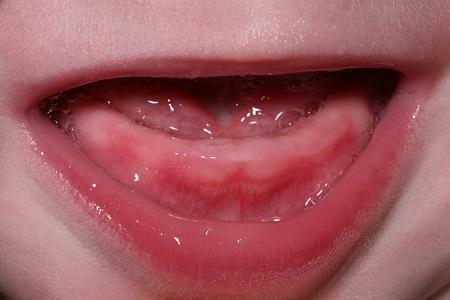
After this moment the next morning, most likely, you will see the tooth itself.
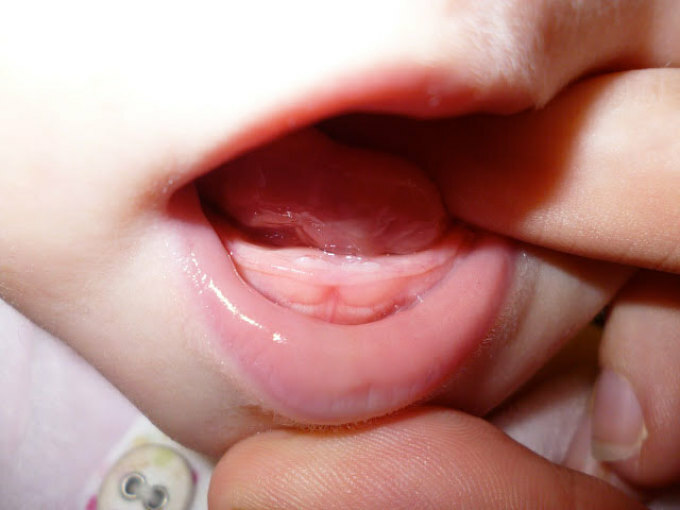
Symptoms of teething in a child
Teething can lead to the following symptoms:
- irritability and tearfulness of the child;
- poor sleep;
- more frequent application to the breast;
- the appearance of a cold;
- a slight increase in temperature - up to 37.5 degrees.
But do not start to worry before the time, because many mothers can boast absolutely imperceptible and easy teething in the child.
IMPORTANT: temperature above 37.5, diarrhea, vomiting, lack of appetite, general weakness of the baby can not be symptoms of teething. If you have them, you should immediately show the child to the doctor.
Scheme of infant teeth and the order of their eruption
By the age of 3 years, your baby should have 20 milk teeth.
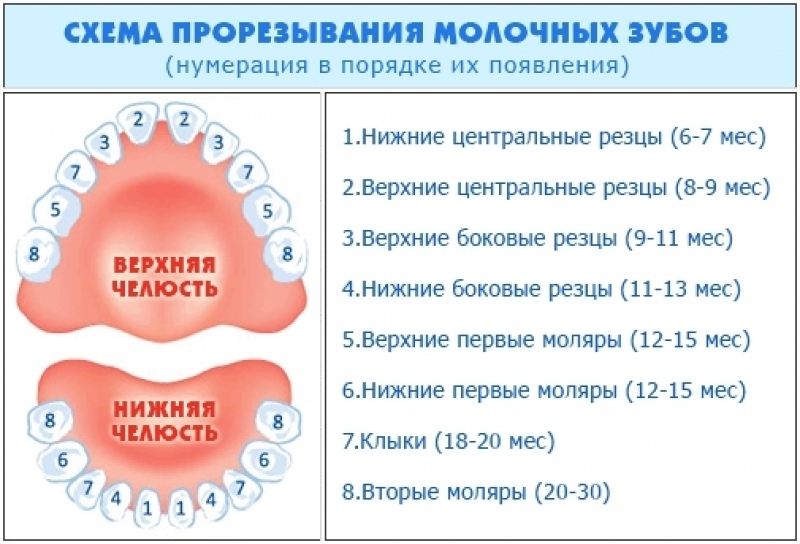
The timing of the eruption is rather arbitrary. If the first tooth of your baby erupted late, then the indicated cutting curve of the remaining ones can be moved forward.
The order can sometimes also be violated. Although sometimes this may indicate the development of diseases, such as rickets, for example.
IMPORTANT: If the timing of the eruption differs from those indicated for more than three months, and the procedure is completely inconsistent, show the child to the doctor.
How to help a child with teething teeth?
The process of teething is very painful. In situations where the child is very worried, you need to try to help him. Here are a few ways:
Teethers for teeth .Slightly calms the pain, performing a kind of massage. However, not all babies like to gnaw them;IMPORTANT: Do not forget that pain medications are taken only when necessary, because this medicine.
Do I need to take care of my baby teeth?
IMPORTANT: Care is required. To begin to care for baby teeth should be after the appearance of the first tooth.
Babies up to a year can be cleaned in two ways once a day:
- wound on a pre-washed finger of an adult gauze or bandage and rub your teeth;
- put on an adult finger special rubber cap for cleaning teeth and clean.
To a child after a year, buy a toothbrush that is age appropriate.
Cleanse twice daily : in the morning after breakfast and in the evening before bedtime. Change the brush every 3 months.
To clean the teeth, it is necessary to move from the gums from the bottom up( for the lower teeth) or from the top down( for the upper teeth).
Diseases of infant teeth
The most common disease of infant teeth is caries. The enamel of the baby teeth is highly prone to external influences. Caries is one of the consequences of this.
In addition to caries, there are sometimes other diseases:
- paradontitis. It leads to early loss of milk teeth. Occurs with weakened immunity of the child;
- periodontitis is the most common complication of caries. Entails serious and long-term treatment;
- pulpitis. It is also a complication of caries left unattended. Often occurs asymptomatically.
IMPORTANT: As you can see, you are not always able to detect a child's tooth disease. Therefore, twice a year, take the child to the dentist.
When is it necessary to lead a child to the dentist?
Parents need to systematically monitor the infant's milk teeth.
If you find any of these signs in your child, you need to contact a pediatric dentist:
- with white, brown or black spots on the tooth enamel;
- tooth hurts when a child chews. You may notice that the baby is trying to chew on one side;
- the child feels special discomfort when eating sweet, sour, salty, cold, hot;
- severe toothache. The child is naughty and refuses to eat.
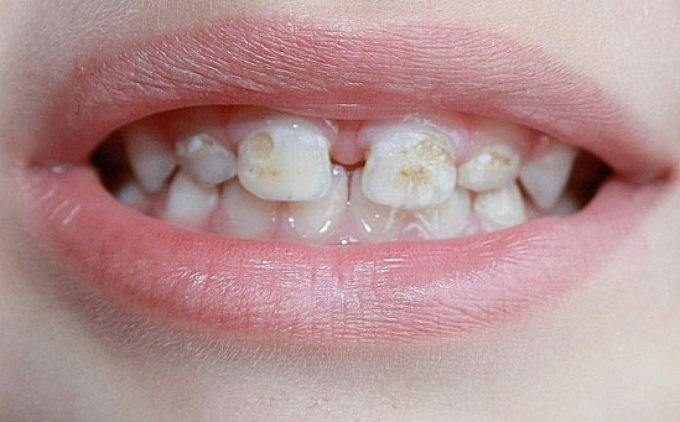
How to prevent diseases of baby teeth?
IMPORTANT: In addition to brushing teeth, observe the following simple rules:
- adults should not lick their baby's nipples and spoons. Your bacteria to anything your baby;
- restrict the child to eating sweets. Harm will also be applied to sweet drinks at night or at night;
- child under two years of age will learn to drink a few sips of clean water after a meal. Baby from two years of teaching to rinse your teeth after eating;
- visit the dentist regularly;
- Teach the child to fall asleep with a bottle in his mouth;
- , try not to allow mechanical injuries to the enamel.
Change of milk teeth or when children have teeth falling out?
The beginning of the change of milk teeth falls on the age of 5-7 years. The procedure is approximately the same as with the eruption of milk teeth. But with the eruption of permanent teeth, 8-12 teeth are added, which the child did not previously have.
First, teeth appear that were not there before - the first molars. It happens in 6-7 years. Further, the incisors are replaced( 6-9 years).In 9-12 years the first premolars, second premolars and fangs change. Well, the process of eruption of permanent teeth is completed by the appearance of second premolars( 11-12 years) and third premolars, called teeth of "wisdom"( 17-25 years).
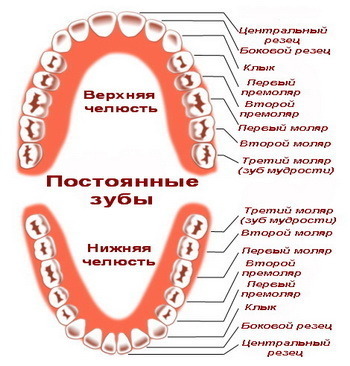
IMPORTANT: These terms are also conditional, as with the eruption of milk teeth.
Conditions for beautiful permanent teeth
By the time of the appearance of permanent teeth between the baby's teeth, the child should have gaps due to active growth of the jaw. These gaps are needed to ensure that permanent teeth, which are much larger than milk in size, have enough space. Otherwise, the tooth will croak or be less than necessary. In more complex cases, the tooth may be outside the dentition.
IMPORTANT: If by the time of eruption of permanent teeth, there is no gaps between the dairy teeth - always consult a child's orthodontist. Perhaps the problem can be solved at an early stage of occurrence.
As you can see, teething is a natural process. But parents still need to know about this process more, to avoid in the future problems with the teeth of the baby.
